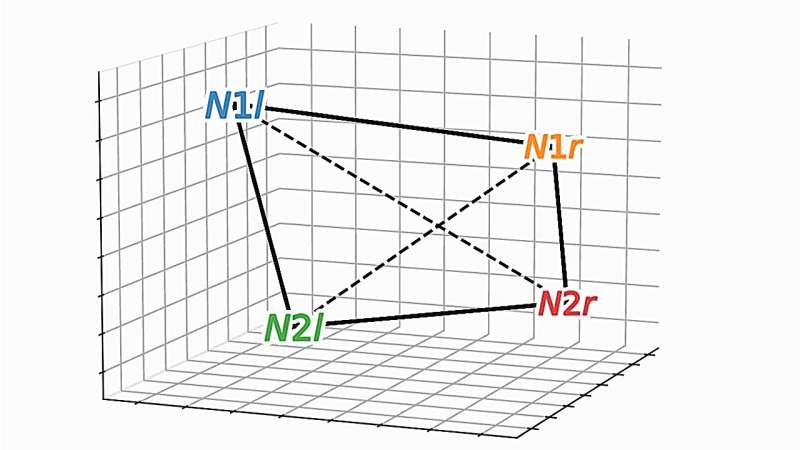This article has been reviewed according to Science X's editorial process and policies. Editors have highlighted the following attributes while ensuring the content's credibility:
fact-checked
peer-reviewed publication
trusted source
proofread
Can a single brain region encode familiarity and recollection?

The human brain has the extraordinary ability to rapidly discern a stranger from someone familiar, even as it can simultaneously remember details about someone across decades of encounters. Now, in mouse studies, scientists at Columbia's Zuckerman Institute have revealed how the brain elegantly performs both tasks.
"These findings are the first evidence that a single population of neurons can use different codes to represent novel and familiar individuals," said co-corresponding author Stefano Fusi, Ph.D., professor of neuroscience at Columbia's Vagelos College of Physicians and Surgeons, a principal investigator at Columbia's Zuckerman Institute and a member of Columbia's Center for Theoretical Neuroscience.
In a paper published in Neuron, Columbia scientists explored social memory, the ability to remember encounters with others. This form of memory consists of two distinct mental processes—distinguishing novel and familiar individuals, and recalling details about those who are recognized.
"We can readily determine whether someone is familiar but may have difficulty in recollecting the details of where and how we know that individual, especially when encountered out of context," said co-corresponding author Steven A. Siegelbaum, Ph.D., who is also Chair of the Department of Neuroscience at Columbia's Vagelos College of Physicians and Surgeons.
Prior work found it difficult to pinpoint how the brain performs both tasks, given their conflicting demands. The ability to detect whether somebody is familiar or not has to apply across many different locations and events, while recollection involves remembering many specific experiences regarding a given individual.
In the new study, the scientists investigated a brain area called CA2, part of the hippocampus, a pair of seahorse-shaped brain structures essential for memory. Dr. Siegelbaum previously made the groundbreaking discovery that CA2 neurons are specifically important for social memory.
The researchers analyzed the brains of mice using calcium imaging, a technique that relies on genetically altered cells—in this case, in CA2—that rapidly change color when active. Calcium imaging enabled Lara Boyle, a former MD-Ph.D. student in the Siegelbaum lab and co-first author of the study, to precisely know which neurons they were examining.
"This helped clear up uncertainty from previous research when it came to distinguishing the mouse brain's responses to novel and familiar individuals," said Dr. Siegelbaum, the Gerald D. Fischbach, MD, Professor of Neuroscience and of Pharmacology, and a principal investigator at the Zuckerman Institute.
The scientists first recorded how the rodents' CA2 cells reacted when they were exposed either to a pair of strangers or a pair of familiar littermates. They next used computational methods, led by Dr. Fusi's team, to analyze the pattern of activity in roughly 400 to 600 neurons in CA2.
The scientists found the same population of neurons encoded memories of both familiar and unfamiliar individuals. Unexpectedly, the neurons used different patterns of activity depending on a mouse's level of familiarity with another rodent.
When mice were exposed to other mice that were unknown to them, the resulting activity in CA2 was relatively simple or, in the scientists' parlance, "low-dimensional." It's as if several members of an orchestra played the exact same notes, explained Dr. Fusi. In contrast, exposure to familiar littermates led to more complex, high-dimensional CA2 activity, as if the musicians all played different melodies.
The calculations and the simulations of the researchers suggest that the more complex, or higher-dimensional, neural activity can help the brain encode the detailed memories of past encounters with familiar individuals. In contrast, the simpler, or lower-dimensional activity can help the brain reliably identify novel individuals across different contexts.
"When you encounter someone new, you may use abstract categories to describe them in your head—for instance, that's a child, with brown hair, red backpack," said postdoctoral research associate Lorenzo Posani, Ph.D., a co-first author on the study who led the computational analysis. "Then, as you get to know them, they become a specific person and personality."
This fundamental discovery regarding the way in which details about others are encoded may shed light on disorders affecting memory.
"When we look at different mouse models of human diseases like schizophrenia or Alzheimer's that are known to affect memory, we now can ask more precisely how the neural activity supporting familiarity detection and recollection might be altered," Dr. Siegelbaum said.
"Our hope is that what we have learned may lead to a better understanding of the types of interventions that can rescue memory deficits in those disorders."
More information: Tuned geometries of hippocampal representations meet the computational demands of social memory, Neuron (2024). DOI: 10.1016/j.neuron.2024.01.021. www.cell.com/neuron/fulltext/S0896-6273(24)00047-3





















